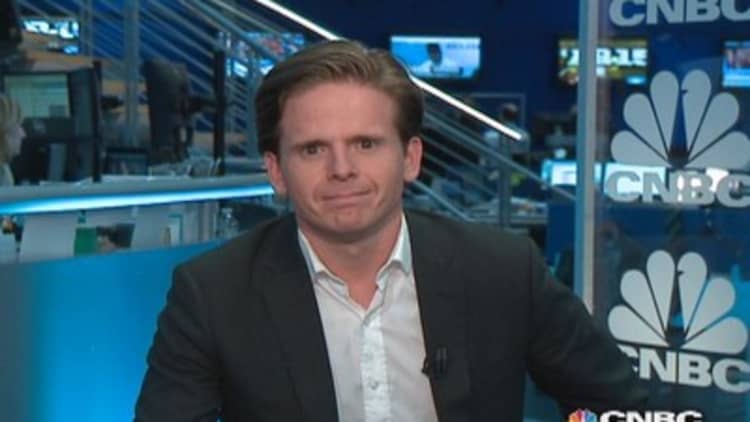
Yield-hungry investors who have turned to the stock market for bond substitutes may soon lose their appetites.
Early last year, investors found themselves in a bind: The global recovery didn't look convincing enough to bet on cyclical stocks, but putting money in fixed income had little appeal with rates essentially at zero. In response, many investors adopted well-known consumer staple stocks with bond-like characteristics.
The likes of Swiss food giant Nestle, French cosmetics company L'Oreal, and U.S.-based bleach maker Clorox seemed to fit the bill perfectly. While none looked likely to deliver huge growth, they seemed to have dependable cash flows and healthy, stable dividend yields.
Consider Clorox. The company offered a roughly 3 percent dividend yield, nearly twice what investors would be paid if they bought the company's own five-year bonds. It was also projected to have mid-single-digit earnings growth for the foreseeable future. And the stock rarely had posted losing years.
Similar qualities at the other staples companies made the group the darlings of the market. The stocks outpaced their local benchmarks and reached price/earnings multiples that were at or near records.
But in the last 12 months, the group turned out not to be so safe. While the has risen 22 percent, Clorox has risen a mere 1 percent, Nestle has declined 7 percent, and L'Oreal has fallen 9 percent.
The trouble was that the stocks were priced at such a premium that even a small disappointment was bound to hurt them. As Philip Isherwood, an analyst with London-based Absolute Strategy Research, points out, consensus earnings estimates for global stocks have historically been 9 percent too high anyway.
One problem that caught some investors off-guard: emerging markets volatility. Even a company like Clorox, which gets 80 percent of its revenue from the U.S., has enough exposure to developing markets to cause headaches.
Most of Clorox's international business is in South America, which has been hit by severe currency devaluations. Argentina accounts for 4 percent of Clorox's revenue and Venezuela contributes 2 percent, estimates John Faucher, an analyst with J.P. Morgan.
Venezuela is especially difficult because foreign companies have lost access to the official exchange rate in the last several months, effectively trapping their money there. If local currency is exchanged on the black market, it would be worth a small fraction of what companies have reported. Clorox declined to comment.
(Read more: 'Latin eBay' has a problem: Venezuela)
Clorox's domestic business has also been a disappointment, largely due to factors beyond the company's control. Retailers like Wal-Mart have said consumers remain frugal even as the economy slowly recovers. Bad winter weather has also interrupted normal shopping habits and can even lead to temporary plant closures, slowing production.
All this has prompted analysts to slash their forecasts for Clorox. The consensus estimate for 2014 earnings per share has fallen to $4.45, down 5.3 percent from $4.70 a year ago.
Nestle, widely considered a top-notch operator, has also slipped. The company generated 4.6 percent organic sales growth last year, short of its target of 5 percent to 6 percent, and signaled it may miss the goal again in 2014. The company declined to comment.
Perhaps surprisingly, this is partly the result of low inflation and in some cases deflation across Nestle's territories. The company has historically been able to pass on higher costs—and even a little bit more—to consumers when input prices rose. But last year, the company eked out pricing growth of only 1.5 percent, well below levels in previous years when commodity costs were soaring.
To revive sales growth, Nestle probably needs to invest further in brands and production capability, potentially putting earnings under pressure. Analysts expect a mere 2.4 percent increase in earnings before interest, taxes, depreciation and amortization (EBITDA) in 2014, following a 1.8 percent rise in 2013.
L'Oreal also may need to step up investments and promotions to stimulate its business. Like-for-like sales in its key North American division rose only 3.8 percent in 2013 after rising 7.2 percent in 2012.
China is also a big question mark. Nomura points out that the country accounted for about 15 percent of L'Oreal's sales growth in 2013, but the economic slowdown could have a big impact on the cosmetics market.
It's hard for L'Oreal investors to find another catalyst to drive the shares higher. The company recently agreed to buy back several billion euros worth of its stock from Nestle, which will boost the French company's earnings per share. But analysts only expect EBITDA to rise 2.5 percent in 2014. L'Oreal didn't respond to a request for comment.
There's no doubt that consumer staples with some of the world's best-known brands will eventually get back on track. But even after their weak recent performance, the stocks still look expensive by historical standards. Nestle trades at 18.2 times consensus forward earnings, compared with a five-year average of 16 times. Similarly, Clorox trades at a multiple of 18.9 times versus 16 times over the last five years, and L'Oreal at 20.7 times, above its five-year average of 19.7 times. With so much that can still go wrong in the near term, the dividends may not look so great.
—By CNBC's John Jannarone. Follow him on Twitter @jannarone
CORRECTION: Analysts expect Clorox to report 2014 earnings per share of $4.45, which was revised downward 5.3 percent from $4.70 a year ago. Those figures were misstated in an earlier version of this article.

